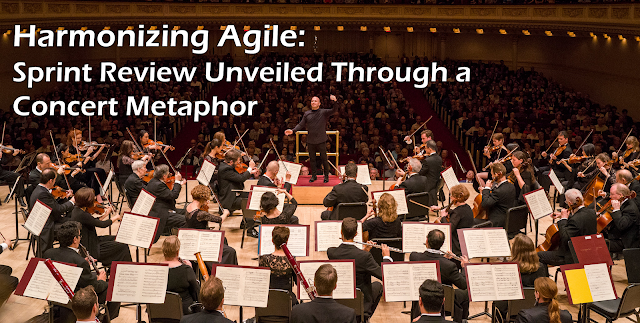After discovering
the agile world, I've found that building analogies can be an engaging way to
understand and explain the dynamics of agile practices.
The
question that sparked this analogy was simple yet profound: What if the Sprint
Review was a concert?
As we delve
into the world of agile development, the Sprint Review stands as a pivotal
moment, like the anticipation before a concert begins. Picture the stage being
set, instruments tuned and the performers ready to perform… so join me in my
thoughts and let us embark on a journey where agile methodologies meet the
harmonies of classical music and introduce ourselves to the Sprint Review
Concert.
The Orchestra
The
Development Team takes center stage, embodying the orchestra. Each member is a
skilled musician, contributing their unique expertise to create a symphony of actions
that produce code and functionality. Like the instruments in an orchestra, the
team members collaborate to produce a cohesive and harmonious product during
the sprint. As they blend their sounds to craft a majestic composition, the Development
Team harmonizes their skills and efforts to deliver a potentially shippable
product increment. Their performance is a testament to agile principles,
demonstrating collaboration, adaptability, and a commitment to continuous
improvement.
The Conductor
Every great
concert needs a conductor to guide and synchronize the orchestra. In our agile
concert, the Scrum Master steps into the role of the conductor, ensuring that
the development process flows smoothly. Like a conductor navigating the musical
score, the Scrum Master facilitates Scrum events, maintains a steady tempo, and
removes impediments that may disrupt the rhythm of the team.
With
gestures of servant leadership, the Scrum Master orchestrates an environment where
the Development Team can perform at its best. They foster collaboration,
encourage creativity, and set the stage for a successful Sprint Review concert.
The
Composer
In our
analogy, the Product Owner assumes the role of the composer. The Product Owner
defines the overarching vision and goals for the product. Is the composer of
the backlog, outlining the features and functionalities that make up the
product's symphony.
During the
Sprint Review concert, the Product Owner eagerly anticipates hearing the
composition come to life. The product owner provides valuable insights and
context, ensuring that the performance aligns with the audience's expectations
and the broader objectives of the organization.
The Score
Sheet
Just as a
musical composition is captured on a score sheet, the Product Backlog serves as
the blueprint for our agile concert. It contains the notes and instructions
that guide the Development Team in creating the product increment. The score
sheet evolves, with new compositions (user stories) added and refined over
time.
The Scrum
Team, akin to skilled musicians, consults the score sheet (Product Backlog) to
understand their cues and deliver a performance that resonates with the
stakeholders.
The Concert
Hall
In our
analogy, the Sprint Review meeting becomes the concert hall—a space where the
audience gathers to witness the culmination of the Development Team's efforts.
The audience comprises stakeholders, whose role is crucial in shaping the
narrative of the agile symphony.
The Audience
The
stakeholders, much like an enthusiastic audience, attend the Sprint Review
concert to witness the unveiling of the latest product increment. They engage
with the performance, providing applause and feedback that enrich the
collaborative process. The stakeholders are not passive observers; their
participation is integral to the success of the concert.
As the
Sprint Review concert unfolds, stakeholders actively participate by applauding
the accomplishments of the Development Team. This applause serves as recognition
and encouragement for the hard work invested in the sprint. It is a moment of
shared celebration, akin to the applause that reverberates through a concert
hall when a particularly moving piece is performed.
Beyond
applause, stakeholders offer valuable feedback, much like a discerning audience
providing insights on the performance. This feedback shapes future compositions
(sprints), guiding the orchestra (Development Team) toward continuous
improvement and an ever-refined agile symphony.
Just as a
concert is followed by encore performances, the Sprint Review sets the stage
for the next agile composition. The melody of collaboration, transparency, and
adaptation continues to resonate as the agile concert unfolds across multiple
sprints. It is not just a moment in time; it is an ongoing, dynamic performance
where the agile symphony evolves, enriching both the performers and the
audience on their journey of continuous improvement.

